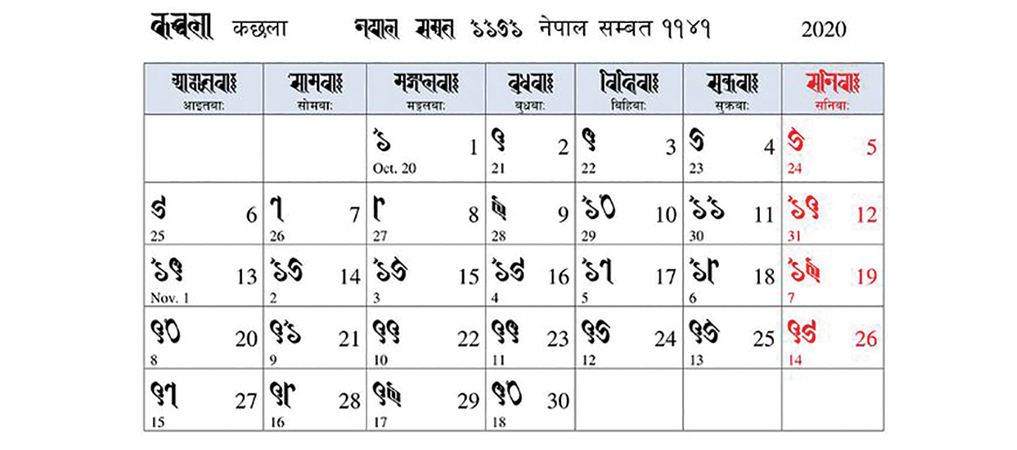Nepal Sambat gets solar calendar for the first time

By Aashish Mishra
Kathmandu, Oct. 20: Nepal Sambat 1141 begins today (October 20). But, hang on! Don’t Nepal Sambat (NS) years begin from Mha Puja? Yes, they do in the lunar calendar. But from this year, Nepal Sambat has a new solar calendar, developed by Newa activists Rukshana Kapali, Supriya Manandhar, Sanyukta Shrestha and Subhash Ram Prajapati, which begins today Kachhalā 1.
The traditional lunar calendar is primarily based on the phases of the moon (tithis) which limits its scope for official use. So various researchers and campaigners had been pointing out the need to develop a solar calendar based on dates over the past three decades. However, the idea hadn’t taken off the ground until last June when Kapali, 21, began initiating discussions with various stakeholders. This led to her teaming up with Manandhar, 33, Shrestha, 41, and Prajapati, 40, to devise an NS calendar that could be regular, practical and fill in the gaps of the lunar one.
The team is diverse. Kapali is a writer and activist, Manandhar is a digital artist, Shrestha is a games developer and Prajapati is an ethnomusicologist and software engineer. But they all instantly bonded with their shared goal and enthusiasm and began working on a date-based calendar for an era that has been exclusively guided by tithis for the last 1,140 years.
“We approached NS scholars who have studied this field and have called for its preservation and practicality,” said Shrestha. “We also approached a few organisations on a personal level. We didn’t want to merely present ideas but also back them up with logic and have concrete examples of how they would actually work,” Prajapati added.
However, it is the time of COVID-19 and there are restrictions on meetings and mobility. But that did not hinder the team much in their efforts. “All research and discussions took place online,” said Kapali.
Every one of the four was dedicated to the cause and none of them did it for financial incentives. Hence, the groundwork involved very little costs. However, the publication required money. The original plan was to print calendars, annual planners and information booklets but monetary constraints forced the team to only publish a few copies of the calendar through crowdfunding.
Solar NS is patterned to a consistent cycle of 365 days with 12 fixed months Kachhalā, Thinlā, Ponhelā, Sillā, Chillā, Chaulā, Bachhalā, Tachhalā, Dillā, Gunlā, Yanlā, Kaulā. The first five months have 30 days each, the sixth month has 29 days and the remaining six months have 31 days each. During leap years, an extra day is added to the sixth month.
As to why the solar year commences from October 20 and not Mha Puja like the lunar year, Kapali explained, “Subhash [Ram Prajapati] suggested that since Nepal Sambat originally began on 20 October, 879, we should begin the solar year 1141 from October 20.”
The team believes that the solar calendar will address the irregularities of the lunar one, help Nepal Sambat adapt to the times, establish a perpetual calendar (since the days and months are fixed, future calendars can also be set in advance) and revive its public usage. The calendar’s digital version, as well as additional information and resources, can be found at the central directory nepalsambat.org.
But not everyone appears convinced. Many senior citizens have expressed reservations about using the calendar and fear its impacts on Newa culture. To this, Kapali responded, “The solar calendar will not replace the lunar one, it will only complement it. The festivals and rituals will continue to follow the lunar calendar while the solar calendar will be for record-keeping and administrative use. Both have their value.” Manandhar also elucidated, “As the Gregorian and Bikram eras do not hamper our celebrations, this solar calendar won’t too.”
These reservations aren’t shared by the youths, though, according to the team, who have received enthusiastic response and support for their endeavour.
The group hopes that organisations and bodies associated with Nepal Sambat adopt and promote the solar calendar recognising its role in promoting the era to the masses and facilitating its use in official/governmental capacities.
Recent News

Do not make expressions casting dout on election: EC
14 Apr, 2022
CM Bhatta says may New Year 2079 BS inspire positive thinking
14 Apr, 2022
Three new cases, 44 recoveries in 24 hours
14 Apr, 2022
689 climbers of 84 teams so far acquire permits for climbing various peaks this spring season
14 Apr, 2022
How the rising cost of living crisis is impacting Nepal
14 Apr, 2022
US military confirms an interstellar meteor collided with Earth
14 Apr, 2022
Valneva Covid vaccine approved for use in UK
14 Apr, 2022
Chair Prachanda highlights need of unity among Maoist, Communist forces
14 Apr, 2022
Ranbir Kapoor and Alia Bhatt: Bollywood toasts star couple on wedding
14 Apr, 2022
President Bhandari confers decorations (Photo Feature)
14 Apr, 2022









